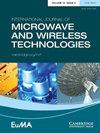通过残差卷积神经网络实现鲁棒自适应波束成形
IF 1.3
4区 计算机科学
Q3 ENGINEERING, ELECTRICAL & ELECTRONIC
International Journal of Microwave and Wireless Technologies
Pub Date : 2023-12-11
DOI:10.1017/s175907872300140x
引用次数: 0
摘要
针对包括期望信号的协方差矩阵和信号转向向量不匹配会降低波束成形性能的问题,本文提出了一种基于残差卷积神经网络(RAB-RCNN)的有效鲁棒自适应波束成形(RAB)方法。在所介绍的方法中,RAB-RCNN 模型是通过引入一个残差单元来设计的,它可以从信号样本协方差矩阵中提取更深层次的特征。利用残差噪声消除和干扰功率估计来重建期望信号协方差矩阵,并通过对重建的期望信号协方差矩阵进行特征值分解来修正不匹配的转向矢量(SV)。利用投影法重新设计信号干扰加噪声协方差矩阵。训练后的模型无需进行复杂的矩阵运算(包括信号协方差矩阵的矩阵反转),就能快速、精确地输出预测的波束成形权重向量,从而缩短波束成形的计算时间。仿真证明了所提出的方法对到达方向估计误差、传感器位置误差和局部散射干扰造成的 SV 失配具有鲁棒性。本文章由计算机程序翻译,如有差异,请以英文原文为准。
Robust adaptive beamforming via residual convolutional neural network
Aiming at the problem that the covariance matrix includes the desired signal and the signal steer vector mismatches will degrade the beamforming performance, an effective robust adaptive beamforming (RAB) approach is presented in this paper based on a residual convolutional neural network (RAB-RCNN). In the presented method, the RAB-RCNN model is designed by introducing a residual unit, which can extract the deeper features from the signal sample covariance matrix. Residual noise elimination and interferences power estimation are utilized to reconstruct the desired signal covariance matrix, and correct the mismatched steering vector (SV) by the eigenvalue decomposition of the reconstructed desired signal covariance matrix. The projection method is utilized to redesign the signal interference-plus-noise covariance matrix. Furthermore, the beamforming weight vector is calculated with the two parameters obtained before and used as the label of the RAB-RCNN model, The trained model can rapidly and precisely output the predicted beamforming weight vector without complex matrix operations, including the matrix inversion of the signal covariance matrix, so that the calculation time can be reduced for beamforming. Simulations demonstrate the robustness of the presented approach against SV mismatches due to the direction-of-arrival estimation error, sensor position error, and local scattering interference.
求助全文
通过发布文献求助,成功后即可免费获取论文全文。
去求助
来源期刊

International Journal of Microwave and Wireless Technologies
ENGINEERING, ELECTRICAL & ELECTRONIC-TELECOMMUNICATIONS
CiteScore
3.50
自引率
7.10%
发文量
130
审稿时长
6-12 weeks
期刊介绍:
The prime objective of the International Journal of Microwave and Wireless Technologies is to enhance the communication between microwave engineers throughout the world. It is therefore interdisciplinary and application oriented, providing a platform for the microwave industry. Coverage includes: applied electromagnetic field theory (antennas, transmission lines and waveguides), components (passive structures and semiconductor device technologies), analogue and mixed-signal circuits, systems, optical-microwave interactions, electromagnetic compatibility, industrial applications, biological effects and medical applications.
 求助内容:
求助内容: 应助结果提醒方式:
应助结果提醒方式:


